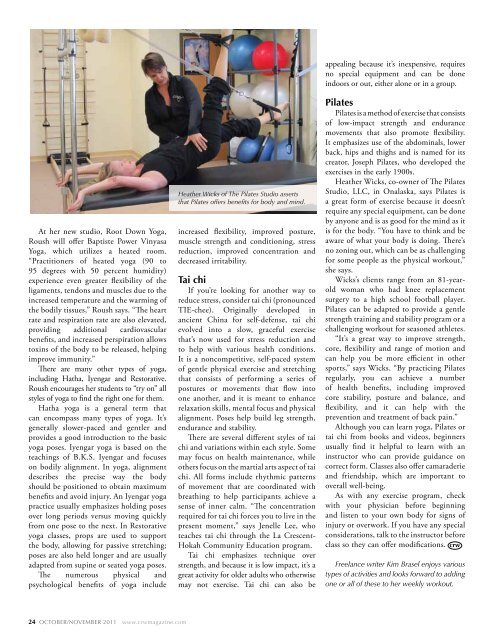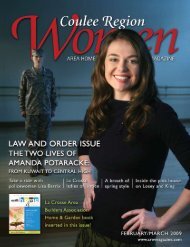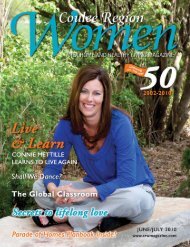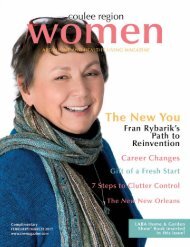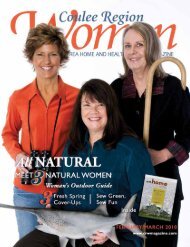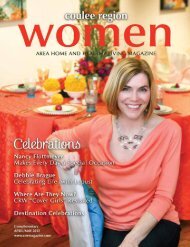October/November - Coulee Region Women's Magazine
October/November - Coulee Region Women's Magazine
October/November - Coulee Region Women's Magazine
Create successful ePaper yourself
Turn your PDF publications into a flip-book with our unique Google optimized e-Paper software.
At her new studio, Root Down Yoga,<br />
Roush will offer Baptiste Power Vinyasa<br />
Yoga, which utilizes a heated room.<br />
“Practitioners of heated yoga (90 to<br />
95 degrees with 50 percent humidity)<br />
experience even greater flexibility of the<br />
ligaments, tendons and muscles due to the<br />
increased temperature and the warming of<br />
the bodily tissues,” Roush says. “The heart<br />
rate and respiration rate are also elevated,<br />
providing additional cardiovascular<br />
benefits, and increased perspiration allows<br />
toxins of the body to be released, helping<br />
improve immunity.”<br />
There are many other types of yoga,<br />
including Hatha, Iyengar and Restorative.<br />
Roush encourages her students to “try on” all<br />
styles of yoga to find the right one for them.<br />
Hatha yoga is a general term that<br />
can encompass many types of yoga. It’s<br />
generally slower-paced and gentler and<br />
provides a good introduction to the basic<br />
yoga poses. Iyengar yoga is based on the<br />
teachings of B.K.S. Iyengar and focuses<br />
on bodily alignment. In yoga, alignment<br />
describes the precise way the body<br />
should be positioned to obtain maximum<br />
benefits and avoid injury. An Iyengar yoga<br />
practice usually emphasizes holding poses<br />
over long periods versus moving quickly<br />
from one pose to the next. In Restorative<br />
yoga classes, props are used to support<br />
the body, allowing for passive stretching;<br />
poses are also held longer and are usually<br />
adapted from supine or seated yoga poses.<br />
The numerous physical and<br />
psychological benefits of yoga include<br />
Heather Wicks of The Pilates Studio asserts<br />
that Pilates offers benefits for body and mind.<br />
increased flexibility, improved posture,<br />
muscle strength and conditioning, stress<br />
reduction, improved concentration and<br />
decreased irritability.<br />
Tai chi<br />
If you’re looking for another way to<br />
reduce stress, consider tai chi (pronounced<br />
TIE-chee). Originally developed in<br />
ancient China for self-defense, tai chi<br />
evolved into a slow, graceful exercise<br />
that’s now used for stress reduction and<br />
to help with various health conditions.<br />
It is a noncompetitive, self-paced system<br />
of gentle physical exercise and stretching<br />
that consists of performing a series of<br />
postures or movements that flow into<br />
one another, and it is meant to enhance<br />
relaxation skills, mental focus and physical<br />
alignment. Poses help build leg strength,<br />
endurance and stability.<br />
There are several different styles of tai<br />
chi and variations within each style. Some<br />
may focus on health maintenance, while<br />
others focus on the martial arts aspect of tai<br />
chi. All forms include rhythmic patterns<br />
of movement that are coordinated with<br />
breathing to help participants achieve a<br />
sense of inner calm. “The concentration<br />
required for tai chi forces you to live in the<br />
present moment,” says Jenelle Lee, who<br />
teaches tai chi through the La Crescent-<br />
Hokah Community Education program.<br />
Tai chi emphasizes technique over<br />
strength, and because it is low impact, it’s a<br />
great activity for older adults who otherwise<br />
may not exercise. Tai chi can also be<br />
appealing because it’s inexpensive, requires<br />
no special equipment and can be done<br />
indoors or out, either alone or in a group.<br />
Pilates<br />
Pilates is a method of exercise that consists<br />
of low-impact strength and endurance<br />
movements that also promote flexibility.<br />
It emphasizes use of the abdominals, lower<br />
back, hips and thighs and is named for its<br />
creator, Joseph Pilates, who developed the<br />
exercises in the early 1900s.<br />
Heather Wicks, co-owner of The Pilates<br />
Studio, LLC, in Onalaska, says Pilates is<br />
a great form of exercise because it doesn’t<br />
require any special equipment, can be done<br />
by anyone and is as good for the mind as it<br />
is for the body. “You have to think and be<br />
aware of what your body is doing. There’s<br />
no zoning out, which can be as challenging<br />
for some people as the physical workout,”<br />
she says.<br />
Wicks’s clients range from an 81-yearold<br />
woman who had knee replacement<br />
surgery to a high school football player.<br />
Pilates can be adapted to provide a gentle<br />
strength training and stability program or a<br />
challenging workout for seasoned athletes.<br />
“It’s a great way to improve strength,<br />
core, flexibility and range of motion and<br />
can help you be more efficient in other<br />
sports,” says Wicks. “By practicing Pilates<br />
regularly, you can achieve a number<br />
of health benefits, including improved<br />
core stability, posture and balance, and<br />
flexibility, and it can help with the<br />
prevention and treatment of back pain.”<br />
Although you can learn yoga, Pilates or<br />
tai chi from books and videos, beginners<br />
usually find it helpful to learn with an<br />
instructor who can provide guidance on<br />
correct form. Classes also offer camaraderie<br />
and friendship, which are important to<br />
overall well-being.<br />
As with any exercise program, check<br />
with your physician before beginning<br />
and listen to your own body for signs of<br />
injury or overwork. If you have any special<br />
considerations, talk to the instructor before<br />
class so they can offer modifications. crw<br />
Freelance writer Kim Brasel enjoys various<br />
types of activities and looks forward to adding<br />
one or all of these to her weekly workout.<br />
24 OCTOBER/NOVEMBER 2011 www.crwmagazine.com


